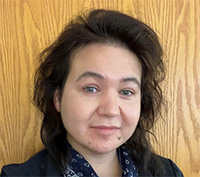
Dr. Rachel Asiniwasis
Dermatologist
Psoriasis is more than skin deep. Understanding its impact helps to manage symptoms.
Psoriasis is a chronic inflammatory skin disease that is estimated to affect up to one million Canadians and about 125 million people worldwide. 1,2 “Psoriasis, in its most common form known as ‘chronic plaque psoriasis,’ is characterized by skin scaling and flaking, patches of inflammation, and symptoms such as skin itching and pain.1,3 However, especially when more severe in nature, modern evidence shows psoriasis is observed to be associated with increased risk of developing other chronic systemic diseases such as psoriatic arthritis, obesity, heart disease, stroke, diabetes, certain types of cancer, and liver disease.3,4,5 Additionally, mental health impacts cannot be understated,” says Dr. Rachel Asiniwasis, a dermatologist in Regina, Sask.
While the exact cause is unknown, psoriasis is thought to be a combination of genetic, environmental, and immune-based factors.3 “Symptoms can range from localized, mild skin symptoms to more moderate, severe, and widespread rashes causing skin pain, swelling, inflammation, cracking and bleeding,” says Dr. Asiniwasis. Areas often affected include the elbows, knees, scalp, extremities, and lower back, however, psoriasis lesions can appear throughout the skin.3 Though most cases start in adulthood, psoriasis can affect people of all ages, sexes, and racial/ethnic groups.6
When I was first diagnosed, we didn’t have all these online communities. There’s a wealth of resources now that people can connect with, so you don’t have to feel alone.
Challenges of living with psoriasis
Psoriasis is not contagious, but it is very visible, which makes the disease extra challenging to deal with. “Many patients experience feelings of embarrassment, self-consciousness, and stigma, which affects their socializing, activities, and the clothes they wear,”3 says Dr. Asiniwasis.

Lena Almeida, age 44, is well familiar with this. She started having an itchy scalp around age 9 or 10, which she managed to control with the help of her doctor. Later, when the psoriasis moved to her lips and elbows, she felt an emotional toll, especially during her teens and twenties.5 “The way I looked affected the way I felt,” says Almeida, who also had to avoid many social activities for fear they might trigger a flare-up. “Looking back on it now, I wish I had advocated speaking to someone to address the emotional aspects of having psoriasis,” she says.
Lena’s story may not be representative of all patients. But fortunately, Lena’s psoriasis is now in remission — meaning her disease is inactive, and she is free of symptoms — but it took a crisis to get her there. A few years ago, Lena woke up one morning unable to walk because her toes and Achilles tendon were extremely swollen. A hospital stay revealed she was in the middle of a severe psoriatic flare. “I was told that up to one in three people with psoriasis can progress to psoriatic arthritis,2 but the best part was I was immediately referred to a rheumatologist and a dermatologist to manage both conditions simultaneously,” she says.
Learn about your options
Now, Lena is grateful for every day. “I’m able to be active, feel good about myself, and thrive as a mother, wife, and entrepreneur,” she says. Her advice to other Canadians living with psoriasis is to insist on a referral to a dermatologist if they feel their symptoms are not being adequately addressed. “It’s mind-blowing to think what could have been if I had my psoriasis in remission decades ago,” she says.
She also encourages people living with psoriasis to take advantage of community support. “When I was first diagnosed, we didn’t have all these online communities. There’s a wealth of resources now that people can connect with, so you don’t have to feel alone.
Speak to your health-care provider about getting a referral to a dermatologist to learn about the many treatment options available.
Visit online communities of support, such as the Canadian Association of Psoriasis Patients, the Canadian Skin Patient Alliance, or the Canadian Psoriasis Network, for additional information.
Brought to you by a biopharmaceutical company.
References
1Canadian Dermatology Association. “Psoriasis.” Canadian Dermatology Association, 19 Oct. 2022, dermatology.ca/public-patients/skin/psoriasis/. Accessed 7 Nov. 2022.
2Psoriasis Journey to Stability: National Report. Canadian Association of Psoriasis Patients (CAPP) Canadian Psoriasis Network (CPN), 2018. www.canadianpsoriasisnetwork.com/wp-content/uploads/2018/09/JTSFinal-r.pdf. Accessed 7 Nov. 2022.
3Mayo Clinic. “Psoriasis – Symptoms and Causes.” Mayo Clinic, 8 Oct. 2022, www.mayoclinic.org/diseases-conditions/psoriasis/symptoms-causes/syc-20355840. Accessed 7 Nov. 2022.
4“Association of Psoriasis With the Risk of Developing or Dying of Cancer: A Systematic Review and Meta-analysis” Trafford AM, Parisi R, Kontopantelis E, Griffiths CEM, Ashcroft DM. JAMA Dermatol. 2019;155(12):1390–1403. doi:10.1001/jamadermatol.2019.3056 https://jamanetwork.com/journals/jamadermatology/fullarticle/2753127
5Muntyanu, Anastasiya, and Elena Netchiporouk. “Psoriasis.” Canadian Association of Psoriasis Patients – CAPP, June 2021, canadianpsoriasis.ca/en/psoriasis/living-with-psoriasis/comorbidities. Accessed 7 Nov. 2022.
6Canadian Psoriasis Network. “About Psoriasis.” Canadian Psoriasis Network, 2 Mar. 2022, www.canadianpsoriasisnetwork.com/psoriasis/. Accessed 7 Nov. 2022.


